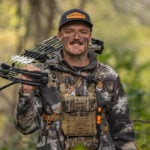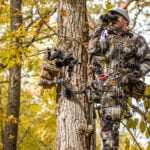Undoubtedly one of the most important decisions a bowhunter faces each season is the location of his or her treestand. It is a decision that will ultimately dictate the success of the season to come. Choose poorly and you could go home empty handed. Choose right and you’ll wrap your tag around a trophy. After countless hours of scouting, years of failed sits and those sweet moments of eventual success, lucky are those who discover a true “Killing Tree.”
You may be wondering, what exactly makes a stand location a “Killing Tree?” Though it may sound simple, it is actually quite complex. It’s more than just a stand that you’ve taken a deer or two from throughout the years. It’s a setup that is nearly bullet proof. One that can be hunted several times throughout the season without generating an overabundance of pressure.
A stand that ultimately continues to provide, time and time again. Like many things in hunting, absolutes are few and far between. So, when you discover a stand location that produces opportunity year in and year out, you absolutely take note. With that being said, let’s dive into the factors that help make a deer killing tree.

Stand Location
It is difficult to begin an article on deer killing trees without first addressing location. Though it may be obvious, location is one of the most important factors simply because if the deer don’t frequent it, then why bother hunting it.
Below, I will briefly cover 3 of the most popular locations for a stand setup that will offer ample opportunity.
- Bedding Areas: These are the locations that deer will use during the day to rest. Often bucks will bed separately from does, which is important to keep in mind throughout the season. Bedding areas are great for morning sits as you wait for the deer to filter back through from their evening food sources to bed. All day sits during the rut can also catch a buck by surprise as he checks these areas for does in estrus.
- Food Source: As the name implies, it is an area where the deer are frequently feeding. Often a better evening sit option, but don’t rule out morning hunts if accessed properly. Keep in mind the different food sources beyond agriculture and food plots. Acorns, apples, native browse, etc. Food sources also shift throughout the season so find what the deer are keying in on early, mid and late season in your area, and adjust your setup accordingly.
- Travel Corridors: A location found between a bedding area and a food source, or between two bedding areas. These travel routes can be hunted throughout the season both mornings and evenings. They can range anywhere from a ridgeline leading to a food source to a brushy fence row between two blocks of timber in ag country. Anywhere the deer utilize cover to get from place to place.
Each one of these locations will vary from region to region, but the way deer use them does not. Locating multiple setups will give you several huntable options come fall. Remember, variety is the spice of life. It is going to be up to you to determine what these spots look like in the areas that you hunt.

Scouting
When choosing a stand location, it is important to do your homework before diving into a tree. Scouting is a key factor to a successful stand location. I like to start by using my HuntStand app to research the topography, examine surrounding properties, and locate limited resources in the area. This ultimately narrows down my search for a potential stand locations.
After dropping a few pins on the map, I get boots on the ground. I like to establish how the deer are utilizing the terrain. I try to determine the preferred bedding in the area; how the deer travel amongst it and what food sources are they seeking within the area. I will also pay close attention to signs, both new and old, to try and paint the picture of what movement to expect as the season progresses.
I then find a tree that offers multiple shot opportunities, preferably overlooking multiple routes that converge within bow range of my setup that also provides ample cover to conceal my movements. I also take note of the huntable wind directions and its patterns throughout the day. Lastly, I ensure that I have several options for quality entry and exit routes for the location.

Access – Entry and Exit
One of the most overlooked, yet most important factors to a great killing tree is access. Bullet proof entry and exit routes to and from your stand location are crucial for success. Without them, you are more likely to kill time than deer. I see it far too often, a hunt that is over before it even begins, and I will be the first to admit that I have learned this lesson the hard way over the years. It does not matter how great the spot is, if you spook everything before you get up the tree then you are bound to have a lonely sit.
To avoid this, there are a few details to keep in mind. First, assess the location of your stand and examine how the deer relate to the surrounding location when you plan to access it. Are they in an ag field feeding in the morning? Maybe they are transitioning back into their beds right before daylight? Perhaps they are bedded on a particular ridge where they can watch you walk in. Regardless of the situation, it is crucial that you take note of when and where the deer tend to be when you enter your setup.

Next, study the “lay of the land” and available access routes to avoid these deer hangouts. In hilly territory, I always utilize the rolling terrain features to access stand locations. Ravines, ditches, the backside of a ridge, field topography, and creeks just to name a few.
When hunting flat land areas, I key in on brushy fence rows, edge habitat such as prairies or standing crops and of course creeks. Anything to hinder their ability to see me accessing my spot is key to a killing tree.
Also, keep in mind the direction your scent will be blowing while you approach your setup. It may be perfect for your stand but awful for your entry, and at that point, the damage has already been done.
This same level of effort needs to be implemented for your exit routes as well. Remember, the deer are scouting you too. Another thing to keep in mind is that the exit route often differs from the entry. Critical for a clean exit is learning where the deer bed after a morning sit or where their evening destination food source is. Having a solid game plan for each setup and knowing how to utilize the terrain without revealing your position is a must.
We, as humans, have a tendency to take the short cut, but often to our detriment. The fastest and quickest walk to the stand isn’t always the best. Develop a game plan, utilize the terrain and put in the extra effort to and from your stand and you are well on your way to finding the killing tree.

Be Adaptable
There is an old saying that “Rome wasn’t built in a day” and more often than not, neither is your killing tree. Rarely do you get the first stand setup perfect. Whatever you do, don’t be hard headed and refuse to adapt, otherwise, failure is imminent. The definition of insanity is doing the same thing over-and-over again and expecting different results. Don’t go insane trying to make a subpar stand location work. If you find a flaw in your game plan, make the necessary adjustments to fix it.
Do you frequently bump deer going to and from the stand? Perhaps you didn’t consider how the thermals would disperse your scent before the day winds stabilized as the mornings or evenings progressed. Or maybe you find yourself just out of the game every single sit. Adapt and overcome, period.

Change that access route from the field edge to the nearby creek. Learn what the thermals do in the mornings and evenings at your setup and adjust accordingly so that you aren’t saturating your spot with human odor waiting on that consistent wind to arrive. Sometimes you just need to shift to a different tree to get yourself back on track. And when all else fails, it may mean bailing on a spot entirely.
It doesn’t matter how great the sign is, if you can’t get in and out undetected and get smelled every sit, it’s time to make a new play in the playbook. If you struggle to find success, there is often a simple fix. But be humble enough to admit your mistakes.
If there’s one thing about mistakes, you must learn from them. Don’t get caught up making the same ones season after season. If it didn’t work the first time, it rarely does the second. Don’t dwell upon them. Learn from them. Move on, and use it as fuel for the fire.
Conclusion
Location, scouting, access, and adaptability. Now that you have all the pieces to the Killing Tree puzzle, it is up to you to piece them together to discover yours. Pay attention to these details next time you’re in the woods, and your stand will be a killing tree in no time.
Head afield with certainty and reap the rewards of your hard work with meat in the freezer or a big buck on the wall. Be safe, and good luck hunting this fall!

 By
By 



